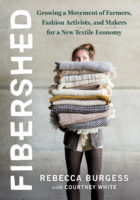“Imagine living in a community where no one had a kitchen, and the closest refrigerator, stove, oven, and cooking pots and pans were all located overseas . . . food would arrive from overseas in boxes with no ingredients list.”
 We would never allow our food system to become so dysfunctional, continues Californian textile specialist Rebecca Burgess — but that is what has happened to the clothing industry in industrial countries. In the USA, 98 percent of all garments are now imported, compared with just five percent in 1965. Fibershed is a welcome plea for a movement to relocalize textile production, similar to that which has revived demand for local foods over the last 20 years.
We would never allow our food system to become so dysfunctional, continues Californian textile specialist Rebecca Burgess — but that is what has happened to the clothing industry in industrial countries. In the USA, 98 percent of all garments are now imported, compared with just five percent in 1965. Fibershed is a welcome plea for a movement to relocalize textile production, similar to that which has revived demand for local foods over the last 20 years.
A fibreshed (as in watershed, not potting shed) is a bioregion that prioritises “place-based textile sovereignty”, focussing on local sources of raw materials, their conversion into clothing, and the connections between all parts of the system “from soil to skin and back to soil again”.
Burgess developed the concept in 2009, after a moment of revelation in an airport, when she was returning from a Navajo reservation where she had been studying natural dyes:
“I looked down at the the plastic chair I occupied and saw my grey stretchy corduroy pants and I realized both were made from the same raw material. I looked at the carpet beneath my feet — it was also made of oil. The jet fuel that would power my ride home — oil. In fact nearly everything surrounding me involved products that originated from fossil fuels extracted from war-torn lands . . . I had a sudden image of a wardrobe that would be made from natural fibres grown within a strategic area centred on where I lived.”
As she explored the matter, she kept uncovering more uncomfortable facts about modern clothing. Production of polyester, which is used in 60 per cent of garments today, consumes 350 million barrels of oil a year and is responsible for three times as many CO2 emissions as cotton production. Rayon, made from wood pulp, is imported into the USA, even though its manufacture is so toxic that has been banned by the US Environmental Protection Agency. Artificial aniline dyes release effluents which can be absorbed by humans and cause endocrine problems in foetuses. Microfibres are shed when plastic clothes are laundered and find their way into rivers, oceans and marine wildlife.
Meanwhile consumers are buying increasing numbers of clothes — 60 percent more than they did 15 years ago, and throwing them away sooner. The average US citizen jettisons almost 80 pounds of clothing every year, bought from fast fashion outlets such as Zara and H&M, which supply thousands of different designs every year almost on a “print on demand” basis. By contrast, the Rana Plaza fire in Dhaka, in which 1,100 factory workers died, highlighted the exploitation of the people employed on miserable wages to churn out these throwaway garments.
Burgess decided to embark on a “wardrobe challenge”, namely a year of sourcing all her own clothing only from her California fibreshed. It was indeed a challenge. She did a lot of darning before discovering that wool from Corriedale sheep was much the best for socks. The region produced a wealth of usable fibres: wool, organic cotton, and the hair of alpacas, llamas and guanaco. The problem was lack of spinning and weaving facilities: California processes just one percent of the wool produced in the state and has only one remaining woollen mill (see photo p.33)
Burgess’s wardrobe year enabled her to contact a wide number of growers and textile workers, who. at the end of her year organized a “Wear the Landscape” fashion show in a feed barn which drew an audience of 200 and generated $6000. The Northern California Fibershed group was formed, going on to organize projects such as a Wool and Fine Fiber Symposium, an on-line market place for producers, and a feasibility study for a Californian wool mill.
The second half of the book examines in more detail the various fibres available within the North California fibreshed, and goes on to describe how the movement has spread across North America and to places such as Australia, Norway, and Bristol, England.
The fibreshed movement has one potential weakness: it may do no more than create niche markets for luxury items that only the well-to-do can afford. Rebecca Burgess is well aware of this, and a main objective of the movement is to create regional infrastructure with economies of scale that enable goods to be sold affordably and competitively. That however is an undertaking of a different order of magnitude from the “wardrobe challenge”.
Fibershed by Rebecca Burgess with Courtney White, Chelsea Green, paperback, 270 pp. 2019.
This article originally appeared as ‘Wear the Landscape’ in The Land Issue 26





